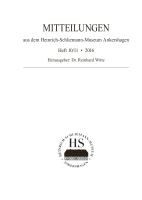
137
HEINRICH SCHLIEMANN:
A NEW DISCOVERER OF CUBA
Maria Castro
Heinrich Schliemann visited Cuba four times: Twice in 1865, once in 1867 and
finally in 1886, when he was already worldwide known for his famous Troy ex-
cavations. He came to the biggest of the Caribbean islands mostly interested in
investments in the Railroad and possible capital profits in Cuban business, but at
the end it was much more than that, because the contact with colonial Cuba and
the Cubans left a deep impression on him, which he put down in writing with ex-
ceptional descriptions of nineteenth century Havana, and other main Cuban cities
and places of the time. His opinions, ideas, comments, thoughts, advices as well
as judgments and even personal emotions, are admirably described in a hundred
and eighty pages of his Travel Diaries referred to Cuba, kept in the Gennadius
Library at Athens, Sections A8, A9, A11 and A16. They are unpublished until now
and written in a very peculiar but understandable Spanish, which I have tried to
translate into English as accurately as possible.
It has been my task for many years to locate the sites he mentioned and follow
his route through our country. Since many of the places he visited do not exist
anymore, or they are transformed or completely changed, I had to take into con-
sideration for comparison, old engravings, pictures, drawings, and documents of
the period, available in Cuban libraries and research centres. Schliemann’s re-
marks are extremely important for the identification of some historical, cultural
and archaeological locations. Although many travellers and authors of different
latitudes, in addition to well known Cuban historians and researchers, have pro-
duced long since abundant literature on the topic, Schliemann’s statements about
architecture, manufacture, trade, industry, landscape, climate, food, transport,
fashions, population, politics, slavery, music, women, theatres, hotels, traditions
and daily life in general, offer a significant source of detailed information written
by a very keen observer.
I
‘As I got up this morning at 5:30, it was already visible the beautiful island of
Cuba and very soon, the city of Havana, afterwards the harbour full of vessels,
ships and steamboats, the houses of different colours and the magnificent palms









